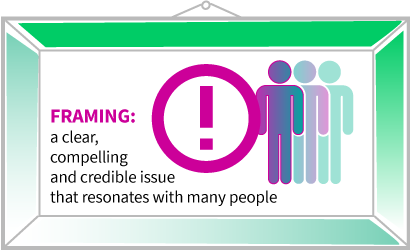

In this section, you will learn about framing or positioning a shared concern or a strongly desired change in ways that are meaningful, persuasive and compelling. Framing is an essential skill for change agents as it can create and promote an understanding of the shared concern by others, fuel an urgent need for a response and foster the motivation and energy for individual and collective action.
What is the key characteristic "Framing"?
Framing is one of the 10 key characteristics of a social movement. It is closely linked to the other characteristics, including shared concern and collective identity.
Framing is about positioning or describing an issue in a way that makes people care about it, and motivates them to join the social movement and take action. Over time, a frame may lose meaning or not be as impactful as a social movement evolves. In these cases, reframing or repositioning an issue may be needed to maintain the level of engagement of change agents (Bibby et al., 2009, Grinspun et al., 2018).
When engaging in framing, you need to decide which issues and goals to focus on and how to communicate them to other people (del Castillo et al., 2016; Grinspun et al., 2018).
You can use several strategies to frame an issue. Some examples: stories; words; slogans; pictures; humour; irony; and performance.
SOURCES: Dementia Action Alliance, 2018; Serna Restrepo et al., 2018.
Why is this key characteristic important?
Framing is compelling, persuasive and dynamic. It is used to gain support, draw people to the cause and mobilize them to act (Alliance, 2009).
Framing, when supported by evidence, positions the shared concern or strongly desired change as credible, with an urgent need for change and action (Bibby et al., 2009).
